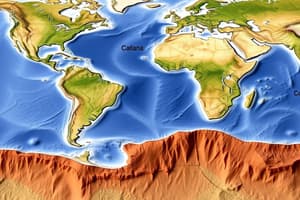Podcast
Questions and Answers
What are the three distinct tectonic divisions mentioned in the text?
What are the three distinct tectonic divisions mentioned in the text?
Answer: Divergent, convergent, and transform boundaries
Which tectonic boundary involves plates moving away from each other?
Which tectonic boundary involves plates moving away from each other?
Answer: Divergent boundary
What type of boundary forms when plates slide past each other horizontally?
What type of boundary forms when plates slide past each other horizontally?
Answer: Transform boundary
What happens at a convergent boundary?
What happens at a convergent boundary?
Which tectonic division is associated with subduction zones?
Which tectonic division is associated with subduction zones?
What geological formation is known as Deccan Trap?
What geological formation is known as Deccan Trap?
What is the Siwalik group known for?
What is the Siwalik group known for?
What is the formation history of the Himalayas?
What is the formation history of the Himalayas?
Where is the Dauki fault located?
Where is the Dauki fault located?
Describe the tectonic subdivisions of the Himalayas.
Describe the tectonic subdivisions of the Himalayas.
Who coined the term Gondwana?
Who coined the term Gondwana?
Which region is associated with the Iron Ore group?
Which region is associated with the Iron Ore group?
What makes up the Delhi Supergroup?
What makes up the Delhi Supergroup?
What geological event led to the formation of the Himalayas?
What geological event led to the formation of the Himalayas?
How did the formation of Gondwana impact the Earth's geography?
How did the formation of Gondwana impact the Earth's geography?
What is the significance of Gondwana in the geological context?
What is the significance of Gondwana in the geological context?
How are Upper and Lower Gondwana sub-divided?
How are Upper and Lower Gondwana sub-divided?
Explain the distribution of Gondwana deposits in the Indian Peninsula.
Explain the distribution of Gondwana deposits in the Indian Peninsula.
Name the three tectonic subdivisions of the Himalayas.
Name the three tectonic subdivisions of the Himalayas.
What are some key features of Gondwana deposits that distinguish them from other geological formations?
What are some key features of Gondwana deposits that distinguish them from other geological formations?
Why is the Hadean to Palaeoarchaean record missing from the Indian stratigraphic succession?
Why is the Hadean to Palaeoarchaean record missing from the Indian stratigraphic succession?
What geological processes led to the absence of Hadean to Palaeoarchaean record in the Indian stratigraphic succession?
What geological processes led to the absence of Hadean to Palaeoarchaean record in the Indian stratigraphic succession?
Explain why the Indian stratigraphic succession does not contain the Hadean to Palaeoarchaean record.
Explain why the Indian stratigraphic succession does not contain the Hadean to Palaeoarchaean record.
Which geological events caused the disappearance of the Hadean to Palaeoarchaean record in India?
Which geological events caused the disappearance of the Hadean to Palaeoarchaean record in India?
What geological factors contributed to the absence of the Hadean to Palaeoarchaean record in Indian rocks?
What geological factors contributed to the absence of the Hadean to Palaeoarchaean record in Indian rocks?
Flashcards are hidden until you start studying




